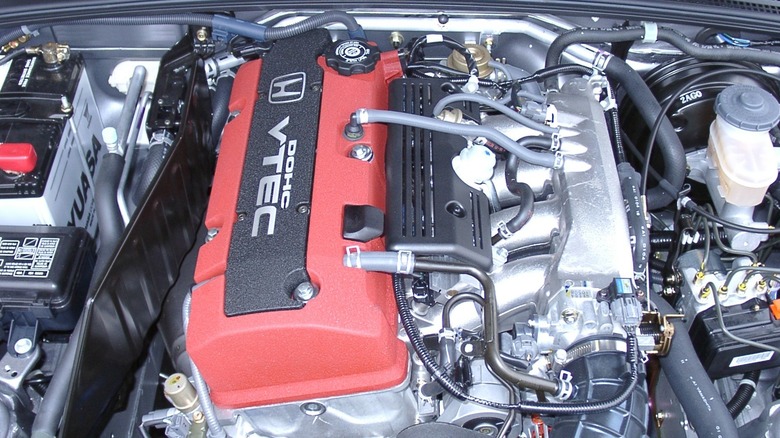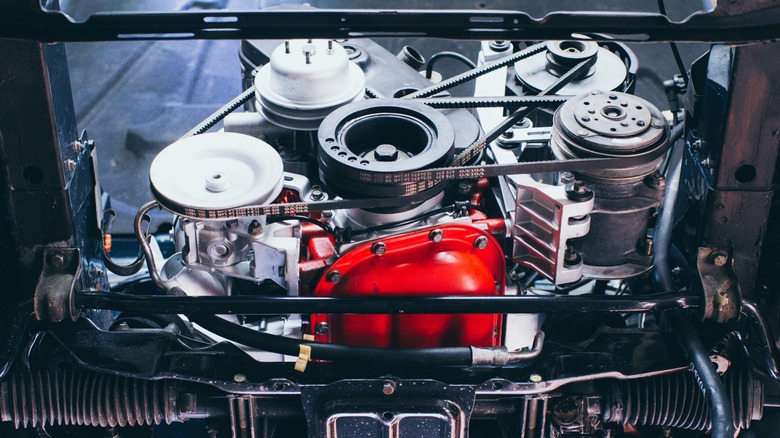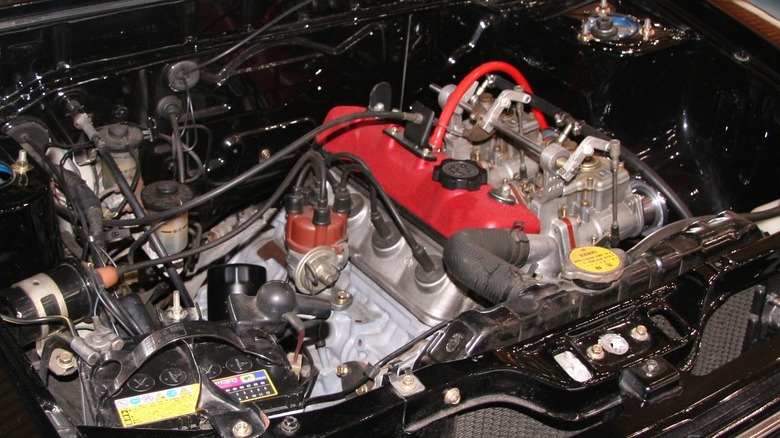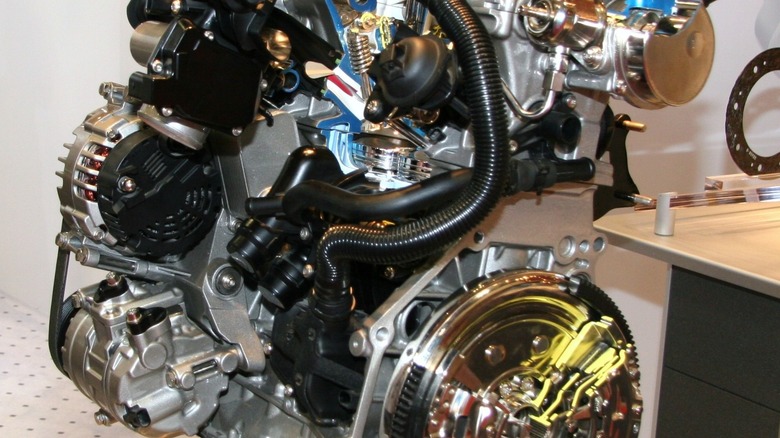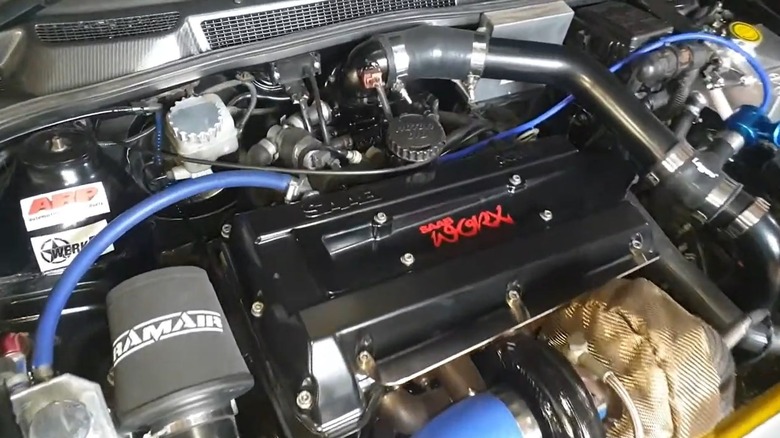10 Super Reliable Inline-4 Engines That Owners Swear By
The in-line four-cylinder is the most widely used car engine in the world. But it wasn't always the case. Following the 1970s and 1980s oil crisis, auto manufacturers began downsizing to smaller powertrains to improve fuel efficiency, but often with insufficient power. Today's four-cylinder engines use superior technology such as direct injection, variable valve timing, and advanced turbocharging to produce more powerful and reliable engines. Some deliver up to 300 horsepower.
The four-cylinder engine offers several advantages over larger six-cylinder or eight-cylinder mills. They are smaller, which makes fitting into a compact car engine bay easier. Fewer cylinders make it lightweight, and only a single exhaust manifold further reduces weight. Four-cylinder engines have only one cylinder head and fewer moving parts than six-cylinder and eight-cylinder powertrains, making them more reliable. The primary engine forces balance with the two outside pistons moving in the opposite direction of the two inside pistons. However, the secondary forces are not balanced since the pistons accelerate faster during the crankshaft rotation's top half than the bottom half. As a result, four-cylinder engines tend to generate more vibration. Some larger four-cylinder engines require balancing shafts to compensate for secondary imbalance vibration.
Four-cylinder engines are easy to work on and, therefore cost less to maintain, and better fuel efficiency means they are less expensive to operate compared to their mainstream competitors. If well maintained, the four-cylinder engine can last over 200,000 miles.
Here are 10 of the most reliable inline-4 engines according to owners.
[Featured image by Pws via Wikimedia Commons | Cropped and scaled | CC BY-SA 3.0]
Ford EcoBoost
When Ford introduced the 2.3-liter EcoBoost engine in the 2015 Lincoln MKC, it was the most powerful four-cylinder in the EcoBoost family, producing 285 horsepower and 305 lb-ft of torque. A year later, the engine was installed in the Ford Explorer and in 2018 Ford equipped the Focus RS with the EcoBoost producing 350 horsepower and 350 lb-ft of torque. Today, EcoBoost engines are found in almost every Ford, from the Fiesta supermini to the Toureno Custom passenger van.
Ford achieved two objectives with the creation of the EcoBoost engine: improved fuel economy with reduced carbon dioxide emissions, and sufficient power to replace larger displacement mills. The engine uses a direct fuel injection system to spray a precisely measured jet of atomized gasoline via a high-pressure injector directly into the cylinder head. The precise delivery results in extremely efficient combustion and therefore requires less fuel for any driving cycle. Turbochargers provide an added boost to the EcoBoost engine with more torque or pulling power at all rpm levels.
Ford engineers went the extra mile to ensure reliability for the 2.3-liter EcoBoost engine, including exhaustive computer analysis, thousands of hours of dyno testing, and vehicle testing at maximum power. According to Cars and Wrenches, the lifespan of the 2.3 Ecoboost lies somewhere between 150,000 and 200,000 miles.
[Featured image by Malchick743 (ALJMW) via Wikimedia Commons | Cropped and scaled | CC BY-SA 4.0]
Volvo Redblock B230FT
Volvo cars have a reputation for safety and reliability, dating back to the 200 series cars produced from 1974 until 1993. The slanted straight-four B21 engine employed a SOHC and an aluminum crossflow cylinder head that replaced the pushrod configuration and iron head used on the previous B20 engine.
The B230-equipped Volvo was the most common 200 series car manufactured between 1985-1995. The base model configuration produced only 111 horsepower at 5,400 rpm and 134 lb-ft of torque at 2750 rpm. Installed in a Volvo 244 model weighing over 3,100 pounds, the acceleration was a lethargic 0 to 60 mph in 12.6 seconds. However, few if any, customers purchased a Volvo for its speed. Safety and reliability were a top priority. According to a 1995 Insurance Institute for Highway Safety report, from 1990 to 1994, Volvo 240 models registered a lower death rate than any other car brand in the US.
"A properly maintained Redblock Volvo will still be running after 200k, 300k, and possibly even one million miles," claims FCP Euro's Jay Boucher. Meanwhile, Classicandsportscar.com wrote that "Volvo's slant-four is a rugged engine capable of 200,000-plus miles between rebuilds, given basic maintenance: rattles and head-gasket failure are the only issues you may find beyond basic wear."
[Featured image by Terabass via Wikimedia Commons | Cropped and scaled | CC BY-SA 4.0]
Toyota 22R/RE
Considered by many to be among the most reliable automotive manufacturers in the world, Toyota has enjoyed a long history of excellence, durability, and dependability. The 22R and RE engines made a significant contribution to Toyota's reputation, often described as the most reliable engines the automaker ever built. Introduced in 1981, Toyota used only the highest quality components for the engine until retired in 1995. While the basic design remained the same, the engine has undergone multiple enhancements, and it has been installed in a variety of vehicles, including the Celica, 4Runner, standard pickup, and Hilux pickup truck.
In 1981, a Toyota Celica fitted with the 2.4L 22R engine and a two-barrel carburetor produced 97 brake horsepower, while the 1991 Toyota Pickup with an enhanced 22R generated 116 horsepower at 4,800 rpm and 140 lb-ft of torque at 2,800 rpm. Toyota also introduced the fuel-injected 22RE version in 1982 and for a brief period from 1985 to 1988 produced a turbocharged 22RTE engine. The 22RE engine featured a hemispherical combustion chamber with a swirl-inducing effect for more complete combustion while the crossflow heads and a long stroke of 3.5 inches produced impressive torque.
A repairpal.com survey of 34 car owners rated the Toyota Pickup with the 22RE engine 4.2 out of 5 stars. "The 22R and RE are by far the most reliable engines Toyota ever built, user DSRacing wrote." "I had three pickups with both the 22R and RE engines and never had a problem. All of them had well over 200,000 miles on them."
[Featured image by TTTNIS via Wikimedia Commons | Cropped and scaled | Public Domain]
Honda F20C/F22C
The Honda S2000 is a two-door, two-passenger sports car built from 1999 to 2009. The front-mid engine rear-wheel-drive layout featured power supplied by the F20C, a naturally aspirated 2.0-liter, and the 2.2-liter F22C four-cylinder engine. The 2009 2.2L model generated 237 horsepower at 7800 rpm and 162 lb-ft of torque at 6800 rpm. The F22C engine produced low torque at a normal driving rpm giving the S2000 smooth operation for daily driving. The feature promotes a longer engine life since only minimal power is required for most driving conditions. Honda's traditional high-performance double-wishbone suspension, and a limited-slip differential provided racetrack handling. Regular checkups and maintenance are key to the S2000's reliability.
Competition for the S2000 came from the first-generation Porsche Boxster and BMW Z4. However, these street-legal cars were designed for the track, employing engines of three liters or more. They are more expensive to maintain, less fuel efficient, and less reliable. Today, twenty-year-old Boxsters can be found for as little as $10,000, while S2000s with reliable F22C engines are selling at well over their original $34,995 asking price.
According to carzin.com, "The reliability of the Honda S2000 is in a class of its own, it has the best reliability despite being classified as a race car, and it is capable of driving 300,000+ miles in its lifetime with minimum maintenance, the only maintenance it needs regularly is the oil change every 6,000 miles." One owner in Edmunds wrote, "The car is a blast! Most fun I have ever had driving! Honda reliability and Ferrari-like performance!"
[Featured image by Hatsukari715 via Wikimedia Commons | Cropped and scaled | Public Domain]
Volkswagen EA888
Volkswagen introduced the four-cylinder turbocharged EA888 in 2004 and since then the engine has been installed in several VW models as well as SEAT and Audi cars. With time, the powerplant has been upgraded and improved to become one of the most reliable and versatile engines on the international market.
The EA888 engine has several design variations but all have a few standard characteristics. Its lightweight construction uses a cast-iron block and an aluminum alloy cylinder head. The engine features a dual overhead camshaft (DOHC) valvetrain, direct fuel injection for improved fuel efficiency and reduced emissions, and a single-scroll turbocharger with an electric wastegate that improves turbocharger response and reduces turbo lag. The EA888 uses a Bosch MED17 engine management system to achieve optimal performance and efficiency by controlling fuel injection and ignition timing. The U.S. version of the Gen3B EA888 engine produces 228 horsepower from 4,700 to 6,200 rpm and 258 lb-ft of torque at 1,500-4,500 rpm.
The Volkswagen EA888 engine is not without its problems, including ignition coil failure, excessive oil consumption, water pump failure, carbon buildup in the intake valves, and others. However, the overall engine series is reliable if maintained properly. "We have seen these engines last up to 200,000 miles if the proper service intervals are maintained and high-quality oil/fuel is used," VW Tuning wrote. Meanwhile, Tombushvw.com referred to VWs as "remarkably reliable vehicles."
[Featured image by TTTNIS via Wikimedia Commons | Cropped and scaled | Public Domain]
Saab B234R
From 1991 to 1997, Saab equipped the 9000 models with the 2.3-liter turbocharged B234R engine. The powerplant generated 225 horsepower when coupled to a manual transmission, and 200 horsepower when mated to the automatic. Saab increased the displacement to 2.3-liter from the previous 2.0-liter B202 engine by simply increasing the stroke by 12 millimeters. The engine used forged connecting rods and a forged crankshaft that provided extra strength under heavy load conditions and helped generate more horsepower than a stock engine. Saab added another significant component to the B234, the Trionic engine management system which makes precise corrections both to the fuel-air mixture and the turbo boost. Mated to the manual transmission, the engine produced 225 horsepower and 300 lb-ft of torque.
In the 1991 Saab 9000 Turbo, a front-wheel-drive, five-passenger, four-door hatchback, the B234R mated to a five-speed manual transmission produced 200 horsepower at 5,000 rpm and 244 lb-ft of torque at 2,000 rpm. Car and Driver test results showed the 9000 Turbo accelerating to 60 mph in 6.4 seconds, reaching the quarter mile in 14.9 seconds at 93 mph, and achieving a top speed of 142 mph.
In addition to excellent performance, the B234R engine proved to be reliable. Mymotorlist.com estimated the lifespan at about 300,000 kilometers (186,000 miles) but others claimed more. One owner from Charlottesville, VA cited the B234R as a vehicle that is "very reliable" and can last around 300,000-500,000 miles. "[The] engine is bulletproof," they remarked. Change the oil every 3,000 miles (regular oil) or 6,000 miles (synthetic), and the base is good for at least 300k."
Honda K24 Series
Honda first offered one of its most reliable engines, the K-series four-cylinder engine, in 2001, and over the past twenty-plus years made 18 variants including the version available today. Many consider the engine to be a model of exceptional efficiency, power, and reliability. Although it has had a few issues (no engine is without them) such as a front crankshaft seal oil leak, the K24 has demonstrated the capacity to reach at least 200,000 miles with regular maintenance.
Among the plentiful variants of the K24 engine, some consider the early K24A2 the best. Honda equipped several models with the engine including the Acura TSX in the U.S. (2004-2008), the JDM Honda Odyssey Absolute (2002-08), and the JDM Accord Type-S (2002-08). It developed a reputation for power, fuel efficiency, and durability. The 2006-08 Acura TSX fitted with a standard K24A2 produced 205 horsepower at 7,000 rpm and 166 lb-ft of torque at 4,500 rpm.
The K-series is perhaps Honda's most adaptable engine family. In its stock configuration, the K24 is a DOHC VTEC design built with a lightweight aluminum block, high-flow cylinder head, and a 10.5:1 compression ratio. The base engine was the ideal platform for a moderate upgrade or a full-blown turbo setup without concern for degrading reliability. The addition of a turbocharger to the factory-stock K24 can boost the output to 400-500 horsepower. However, to retain the engine's reliability, some internals should be replaced with heavy-duty race-oriented components. Transmission and suspension upgrades are also recommended to handle the additional horsepower.
[Featured image by Tennen-Gas via Wikimedia Commons | Cropped and scaled | GNU Free Documentation License]
Subaru EJ20
Subaru first installed the 2.0-liter four-cylinder EJ20 engine in the 1989 Subaru Legacy. It became the engine of choice in several Subaru models for its dependable performance and reliability. A 2015 Subaru Outback owner wrote, "I've had my Outback 2.5i Limited for about two years now and it's been a good value for the car itself. It's at about 104,000 miles so far and I can say it's been relatively reliable."
The Subaru base model EJ20 is a naturally aspirated boxer engine (the pistons move horizontally) using an aluminum cylinder block fitted with dry cast iron sleeves, lightweight pistons, and a low rpm-tuned intake manifold. Subaru equipped some versions with 4-2-1 exhaust headers (four pipes come off the cylinder head leading into two pipes, and finally a single pipe connecting to the catalytic converter and muffler).
The most common model, the EJ20E, is a naturally aspirated SOHC (single overhead camshaft) design made with aluminum alloy cylinder heads and 4 valves per cylinder. Although the engine is rated as very reliable, the camshafts turn via a timing belt from the crankshaft, which should be replaced every 60,000 miles. Subaru produced the EJ20E engine in several generations, each with power output exceeding the previous version in increments of 125, 135, 155, and 140 horsepower at 5,600 rpm (Legacy BL). The EJ20D features DOHC heads and produces 150 horsepower at 6,800 rpm. According to Albert and Robert Bonamici of Auto Master AMR, the Subaru EJ20 engines can be boosted to 300 wheel horsepower using stock internals and a custom fuel management tune.
[Featured image by Qurren via Wikimedia Commons | Cropped and scaled | GNU Free Documentation License]
BMW S14
BMW introduced the M3 in 1986 equipped with a 2.3-liter four-cylinder "S14" engine. Designed by renowned German engineer Paul Rosche, the high-revving engine with roots in the BMW M1 six-cylinder was built for hard driving and proved to be one of the automaker's best. The S14 shares a cast iron block with the M10 engine that excelled in the F1 circuit. It featured a four-valve head derived from the M5's S38 straight-six, machined intake and exhaust ports, and individual throttle bodies. On the M3, BMW mated the S14 to a five-speed dogleg manual gearbox and gave it a racetrack suspension with struts up front and semi-trailing arms at the rear.
Early M3s with the 2.3-liter S14 are rated at 200 brake horsepower and 176 lb-ft of torque, but increased to 215 brake horsepower with special editions produced in 1989. The S14 in the SportEvolution cars was upgraded to 2.5 liters and 238 brake horsepower. The S14 engine pushed the 1,200kg E30 BMW to 60 mph in about 6.7 seconds and a top speed of over 140 mph. It is the most reliable of the E30 engines.
Bimmers.com claimed the S14 was exceptionally reliable. "If maintained well and taken care of, an S14 engine would sail past the 300,000-mile mark without significant problems," the site noted.
KIA Soul 2.0-liter
Kia produced the Soul, a compact crossover SUV, in three generations. The first (2010-2013) and second (2014-2019) generations were fitted with a 1.6-liter Inline-4 while the current third generation is available with an upgraded 2.0L Inline-4. A quirky, boxy design with unconventional looks but a spacious interior, the Soul gained favor with younger drivers searching for a practical, affordable automobile. The Soul provides modern features and reliable performance at an accessible price point.
While earlier models lacked refinement and ride quality, the third generation with the turbocharged engine offers a smooth ride, responsive handling, and acceleration on par with the best cars in the subcompact class. The 2020 Kia Soul 2.0-liter four-cylinder engine generates 147 horsepower and 132 lb-ft of torque, resulting in a lackluster acceleration. However, the 1.6-liter twin-scroll turbocharged four-cylinder produces 201 horsepower and 195 lb-ft of torque. The top-level Turbo trim accelerates to 60 mph in 6.4 seconds and reaches a top speed of 128 mph.
The Kia Soul engine reliability is probably the biggest contributor to the car's overall reliability rating. Most owners have praised its long-term performance and lack of serious issues over time. RepairPal.com gives the Soul a reliability rating of 4.5 out of 5.0, placing it as the third most reliable subcompact in its class. Per Copilotsearch.com, "Different users have shared about having their Kia Souls reach over 200,000 miles without significant problems, while others have faced issues at lower mileage. One user reports 112,000 miles in 23 months, with the Soul still working great."
